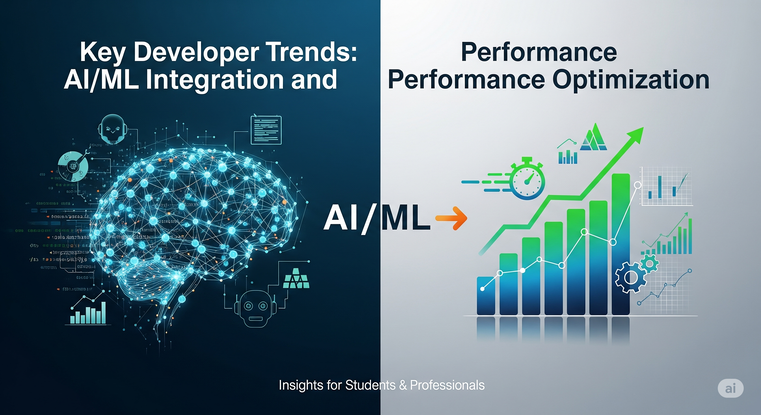
Key Developer Trends: AI/ML Integration and Performance Optimization
Introduction: The Changing Face of Development
The world of software development is in the middle of a historic transformation. The fusion of Artificial Intelligence (AI), Machine Learning (ML), and performance optimization strategies is reshaping how developers approach problem-solving, design, and deployment.
In 2025, AI is no longer a futuristic add-on; it’s the foundation of many development workflows. From writing code to testing, deployment, and optimization, AI is enhancing developer productivity, reducing operational costs, and enabling smarter decision-making.
At the same time, performance optimization has become a key competitive differentiator. Users expect lightning-fast load times, responsive interfaces, and seamless experiences regardless of device or location. This has put optimization at the heart of every developer’s roadmap.
In this blog, we will dive deep into:
-
The role of AI/ML in modern development
-
Cutting-edge performance optimization techniques
-
The emerging trends that will define developer work in 2025 and beyond
-
How developers can adapt to stay ahead in a rapidly evolving tech landscape
AI/ML is no longer an experimental playground for researchers; it’s production-ready technology that powers mission-critical applications in every industry.
1.1 AI-Driven Code AssistanceModern Integrated Development Environments (IDEs) now come pre-loaded with AI coding assistants that:
-
Suggest context-aware code snippets.
-
Automatically detect bugs and vulnerabilities.
-
Provide real-time optimization recommendations.
Examples:
-
GitHub Copilot X – Generates boilerplate code, improves syntax, and helps debug in real-time.
-
Amazon CodeWhisperer – Offers AI-based code completions and security scanning.
-
Tabnine – Learns from your codebase to tailor predictions for your specific style.
Impact:
Developers spend less time on repetitive tasks, allowing more focus on solving complex problems and innovating.
AI models are increasingly used for predictive bug detection and test automation:
-
Predictive testing identifies potential errors before deployment.
-
AI-based regression testing ensures updates don’t break existing functionality.
-
Intelligent test case generation ensures maximum coverage with minimal effort.
Example:
AI-powered tools like Testim and Applitools use computer vision to detect subtle UI inconsistencies across different browsers and devices.
DevOps has evolved into AIOps — integrating AI for better monitoring, alerting, and automated issue resolution.
-
Anomaly detection in server logs before they cause outages.
-
Predictive scaling based on traffic patterns.
-
Self-healing systems that fix minor issues without human intervention.
Many modern applications integrate ML recommendation engines:
-
E-commerce: Personalized product suggestions based on browsing and purchase history.
-
Media streaming: Predictive content recommendations.
-
Healthcare: Personalized treatment plans using patient history.
Developers now embed AI analytics directly into dashboards, enabling:
-
Real-time KPIs monitoring.
-
AI-powered forecasting.
-
Automated data cleaning and transformation.
In the digital age, speed is directly tied to user satisfaction, retention, and conversions.
2.1 Front-End Optimization-
Lazy loading of images and videos to reduce initial load times.
-
Code splitting to only load the JavaScript necessary for the current page.
-
Preloading critical assets for faster first meaningful paint.
-
AI-based UX heatmaps to identify and eliminate slow user paths.
Stat:
Google research shows that a 1-second delay in load time can reduce conversions by up to 20%.
-
Database query optimization using AI-based indexing.
-
Microservices architecture for modular scaling and fault isolation.
-
Edge caching to serve content faster to geographically distant users.
-
Serverless functions for lightweight, high-speed tasks.
-
Implementing offline-first architecture with local caching.
-
Using AI-driven testing to identify performance bottlenecks on low-end devices.
-
Leveraging Progressive Web App (PWA) technology for app-like speed in browsers.
Processing data closer to the source reduces latency dramatically:
-
AI models deployed at the edge for real-time video analytics.
-
IoT devices processing data locally for faster reaction times.
-
AR/VR systems delivering seamless, lag-free experiences.
With sustainability becoming a global priority:
-
Developers are now optimizing code for energy efficiency.
-
AI tools can suggest low-power algorithms to reduce cloud energy consumption.
Generative AI tools can:
-
Create UI mockups in minutes.
-
Auto-generate API endpoints.
-
Draft initial documentation for faster handoffs.
With increasing AI adoption, transparency is key:
-
AI models now provide reasoning trails for their decisions.
-
Improves trust in AI systems for regulated industries.
-
Hybrid AI algorithms inspired by quantum computing.
-
High-speed problem solving for logistics, optimization, and cryptography.
-
Treating AI models like software — with automated testing, version control, and CI/CD pipelines.
-
Regular retraining of models to keep them accurate over time.
-
Threat intelligence platforms powered by ML.
-
Automated vulnerability scanning.
-
Predictive detection of phishing attacks and malware.
-
Learn TensorFlow, PyTorch, Hugging Face Transformers.
-
Understand model deployment via AWS SageMaker, Azure ML, or Google Vertex AI.
-
Lighthouse, WebPageTest, GTmetrix for front-end performance.
-
New Relic, Dynatrace for back-end optimization.
-
Kubernetes for orchestration.
-
AWS Lambda, Azure Functions for serverless computing.
-
Cloudflare Workers and AWS CloudFront for edge deployments.
-
Understand GDPR, CCPA, and AI ethics guidelines.
-
Follow best practices for bias detection and fairness in AI models.
The marriage of AI/ML integration and performance optimization is shaping the future of software development. Developers who embrace AI tools, focus on optimization, and continuously learn emerging technologies will be best positioned for success.
The challenge isn’t just keeping up — it’s leading the transformation.






